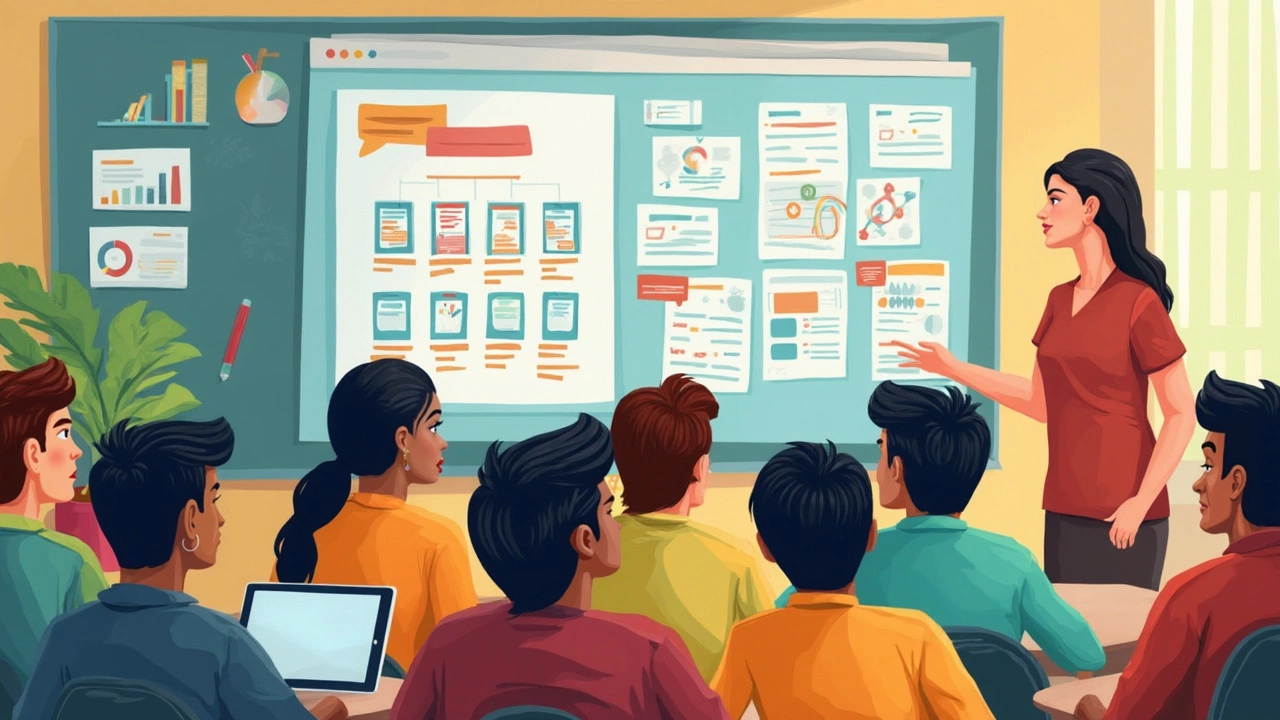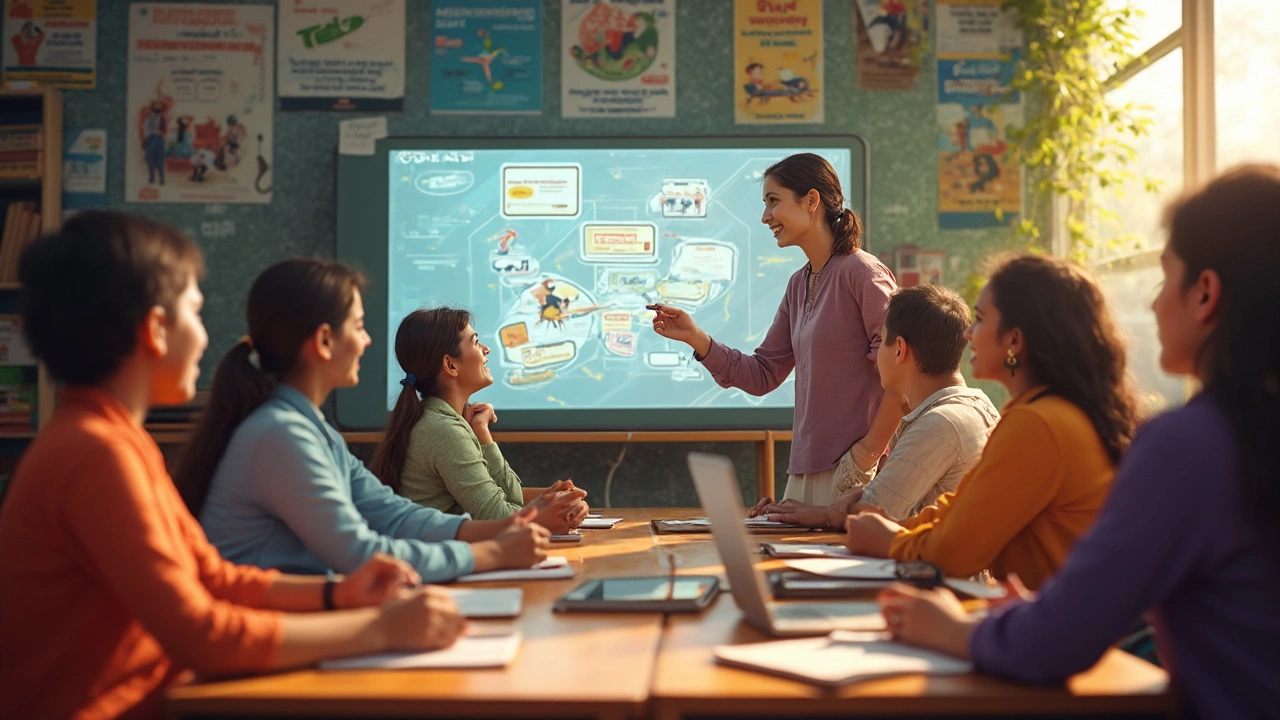Most teachers will tell you the real training starts the moment they walk into a classroom, not when they sit through a slideshow. But with endless courses and programs out there, it’s easy to get lost in the options. Here’s the thing: The best training is the one that sticks when things get tough with real students and packed schedules.
Maybe you’ve sat through workshops where nothing seemed useful the next day. You’re not alone. Studies from 2024 show that teachers remember and use training only when it directly helps them fix problems they deal with daily—like managing an unruly class or figuring out how to use tech without losing their mind. So, if you’re choosing training, put practical over theoretical every single time.
- Why Teacher Training Matters More Than Ever
- Types of Teacher Training That Actually Deliver
- Online vs. In-Person Training: What Works Best?
- Tips for Picking the Right Training for You
- Real-Life Stories: Training That Made a Difference
Why Teacher Training Matters More Than Ever
Classrooms have changed fast in the last few years, and what worked for teachers in the past doesn't cut it anymore. If you look at recent classrooms, tech is everywhere, student needs are more complex, and schools expect more results.
Teacher training isn't just about learning the basics. It's about keeping up with all the new stuff—learning how to handle digital tools, understanding mental health issues, and finding faster ways to get students engaged. In 2023, a poll found that nearly 90% of teachers said new challenges—like online learning and bigger class sizes—meant they needed better, ongoing training, not just a one-time deal.
Here's what makes teacher training so essential right now:
- Tech keeps updating. Teachers have to keep learning to keep up with apps, smart boards, and new learning platforms.
- Student backgrounds are way more mixed. Training helps teachers reach everyone, no matter where they’re from or how they learn.
- The pressure to get results has never been higher. Teachers say practical training gives them the confidence to try new things in class—stuff that actually works.
- Kids face more issues outside school. Better teacher training means staff spot problems early, so nobody slips through the cracks.
If you're wondering if more training really pays off, check this out:
| Year | Percent of Teachers Who Saw Real Improvement After Quality Training |
|---|---|
| 2022 | 61% |
| 2023 | 76% |
| 2024 | 81% |
Good teacher training is no longer a nice thing to have—it's a must-have if you want to keep up and really help students. No shortcuts, no tired old slideshows—teachers need the tools, not just the talk.
Types of Teacher Training That Actually Deliver
The old idea of learning everything in college or a one-off seminar is outdated. If you want to become a better teacher, you need teacher training that’s hands-on and straight to the point. These days, a few types of training come highly recommended by classroom teachers and actual research.
- Peer Coaching: This is when teachers learn from each other, swapping ideas and visiting each other’s classes. According to a 2023 EdWeek survey, over 65% of teachers said they learned more from peer feedback than formal workshops.
- Mentoring for New Teachers: First-year teachers with a solid mentor are way less likely to quit. A study by the Learning Policy Institute showed that mentoring programs can cut new teacher turnover by about half.
- On-the-Job Training (Job-Embedded PD): Instead of pulling you out of your classroom for a seminar, this style gives you short, targeted coaching sessions during the regular school day. Teachers get immediate help and try new ideas right away instead of waiting weeks.
- Content-Focused Training: Want to actually get better at math or writing instruction? This training is built around the subjects you actually teach. Recent curriculum studies say that teachers who get subject-specific coaching see their students’ test scores jump much faster (sometimes by nearly 20%).
- Technology Bootcamps: Since COVID, these have exploded. Whether it’s Google Classroom or another app, fast-paced, tool-based training sessions mean you’re not guessing or wasting hours after school searching for tutorials.
What doesn’t work? Long, general lectures with a bunch of buzzwords and no practical use. Teachers say if it’s not tied to what’s actually happening in their classroom, it won’t last past the end of the week.
| Type of Training | Reported Satisfaction (2024) |
|---|---|
| Job-Embedded PD | 81% |
| Peer Coaching | 75% |
| Mentoring | 69% |
| Online Webinars | 54% |
When choosing teacher training, stick to what’s practical, interactive, and built around real classroom needs. You’ll walk away with skills you’ll actually use, not just a certificate.

Online vs. In-Person Training: What Works Best?
This debate comes up all the time: Should teachers do teacher training online, stick with the classic in-person workshops, or try some mix of both? There’s no single answer, but there’s actually decent data showing what tends to work for real teachers on the ground.
Online training exploded during the pandemic, and a 2023 survey from EdWeek showed over 65% of teachers took at least one online course last year. The big pros? Convenience. You can learn in your pajamas, on your own time, without killing your weekend. There’s also usually more choice—everything from quick, focused courses on classroom tech to deep-dive modules on student mental health.
- Fits busy schedules
- Usually cheaper (sometimes free)
- Self-paced, so you can pause, rewind, and revisit as needed
But let’s be honest: Not everything sticks if you’re just clicking through slides on your phone at midnight. If a course doesn’t make you try out what you learn with other people, it’s easy to forget by Monday.
Enter in-person training. It’s classic for a reason. When you’re face-to-face with other teachers, you ask real questions, do group work, and get honest answers. It also helps you build a network—sometimes the best tips come from teachers over coffee, not in a PowerPoint. Teachers in a 2024 TeachStrong poll said in-person workshops made them 43% more likely to actually use what they’d learned versus just hearing about it online.
| Type | Most Useful For | Common Issue |
|---|---|---|
| Online | Flexible tech training | Hard to stay motivated |
| In-Person | Hands-on skills, real collaboration | Harder to fit into your schedule |
So, what’s best for teacher training? Try blending the two. Many schools are now using hybrid models: do the intro work online, then meet in person for practice and troubleshooting. That way you get the best of both—flexibility plus real connection. One tip: if you ever get the chance to do a trial run before signing up for a full course, do it. The best training is the one that actually gets you excited to teach the next day.
Tips for Picking the Right Training for You
So you’ve got choices, but how do you actually pick the best teacher training for your situation? Don’t just grab the first program that pops up on Google or shows up in your inbox. Here’s what matters.
- Look for relevance. Choose training that tackles what’s actually happening in your classroom. If you’re struggling with classroom management or digital tools, don’t sign up for a course on outdated theory. In 2024, surveys from teacher organizations found about 67% of teachers prefer workshops tied to their real-world needs rather than “big picture” seminars.
- Check the trainer’s background. Is the person actually experienced with students, or just good at making slides? A teacher’s biggest breakthroughs usually come from people who’ve been in their shoes.
- Make sure there’s real practice. The National Institute for Excellence in Teaching points out that training sessions with a hands-on component—like role-playing or active tech demos—lead to 40% better recall a month after the session. If you don’t get to practice, you probably won’t remember it when crunch time hits.
- Peer feedback is gold. Go for groups or coaching sessions where you can swap ideas with other teachers. This is way more helpful than isolated online modules you blast through alone. In one recent study, teachers who talked through ideas with peers during training reported higher confidence and actually stuck with new strategies longer.
- Don’t assume more hours means better results. Short, focused training can be much more effective than marathons. According to a 2023 meta-analysis, scattered short sessions (known as microlearning) beat one-off daylong events by a mile for actual skill use.
You can even break things down with a simple checklist:
- Does the training match my current classroom challenges?
- Is there time to practice, not just watch?
- Will I get feedback from people who know what they’re talking about?
- Can I put these ideas to use right away?
| Type of Training | Best For | Success Rate (2024) |
|---|---|---|
| Peer Coaching | Ongoing skill improvement | 82% |
| Hands-On Workshops | New teaching tools | 76% |
| Online Microlearning | Busy schedules | 70% |
| Lecture-Style Seminars | Theory background | 54% |
Remember, teacher training works best when it helps you solve something real, right now. A little upfront effort picking the right program saves you loads of frustration later.

Real-Life Stories: Training That Made a Difference
Sometimes, the best way to figure out what works in teacher training is to hear it straight from real teachers. Let’s ditch the theory and look at what actually helped them in the classroom.
First, there’s Nicole, a high school English teacher in Texas. She took a year-long mentorship course focused on real-time feedback. Instead of long lectures, she got weekly classroom visits and quick, honest advice. After six months, her classroom management improved so much that even her toughest students paid attention. Not only did her stress go down, but her school saw a 15% jump in reading scores that year.
A second example comes from a primary school in Scotland that tried a professional development project called Lesson Study. Teachers worked in teams, planning and observing each other's lessons and swapping practical teaching tips. One of the surprising takeaways? Teachers said this side-by-side learning was twice as useful as online webinars.
Here’s a quick look at what teachers in a UK 2024 survey said actually helped them after a training:
| Type of Training | % Found It Useful |
|---|---|
| Mentorship/Peer Coaching | 78% |
| Hands-On Workshops | 65% |
| Online Courses | 46% |
So, what made these methods the best? Teachers said it came down to three things:
- Immediate feedback—they fixed mistakes right away instead of waiting months.
- Seeing real examples, not just reading about them.
- Getting to practice new skills with peers, instead of sitting alone in front of a screen.
One last story: Jamal, a middle school science teacher in Melbourne, signed up for a short course on using budget-friendly tech in science labs. Within weeks, he was running hands-on experiments that didn’t break the bank, and his class attendance shot up. He didn’t just learn theory—he got step-by-step instructions and real support until he was confident to try new things.
The message is clear: the best teacher training is practical, supportive, and built around real classroom challenges. That’s the stuff that sticks.





Write a comment